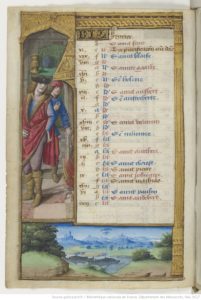
“February”, kalendar page from Les Petites Heures d’Anne de Bretagne (The Little Hours of Queen Anne of Bretagne), by the Maître des Triomphes de Pétrarque. From Bibliothèque nationale de France, Paris (France).
The two brothers were born in Thessalonica, Greece, in the early 9th century. Cyril was originally named Constantine; he took the name Cyril when he became a monk in Rome shortly before his death. Similarly, Methodius was born Michael, and took the name Methodius when he became a monk in northwest Turkey. (Both men were ordained as young men, Cyril to the priesthood, and Methodius to the diaconate.)
In 860, when Cyril was around 37, he was sent by the Byzantine Emperor Michael III and the Patriarch of Constantinople Photius on a mission to the Khazars. In 862, Prince Rastislav of Great Moravia asked Michael and Photius for missionaries to evangelize his Slavic subjects. (Great Moravia covered large portions of current Czechia, Slovakia, Poland ,and Hungary; the name persists as one of the major regions of current Czechia [the Czech Republic]). Rastislav’s motives may have been more political than religious, as he was looking for a way to assert his independence from the Franks. In any event, the two brothers began translating the Bible into Old Church Slavonic. This effort was highly successful; less so was their effort to create a specifically Slavic liturgy.
To translate the Bible, Cyril and Methodius devised a new alphabet—the Glagolitic alphabet, which borrowed heavily from their native Greek, with a couple of borrowings from Hebrew. (The Slavs, being generally antisemitic these days, are loath to acknowledge that.) The Cyrillic alphabet, a descendant script, is now widely used by Eastern and Southern Slavs. The Soviets also used it as the basis for alphabets used to transcribe Siberian indigenous languages.
During their evangelization, Cyril and Methodius crossed paths with missionaries from East Francia, representing the Carolingian Emipre. The Carolingians insisted on using the Latin liturgy, but Cyril and Methodius had been so successful precisely because they were using a native language. The brothers returned to Rome in 868 to plead their case for using the local language, and they won the approval of Pope Adrian II, who made Methodius an Archbishop with jurisdiction over Moravia and Pannonia. (The fact that they brought with them the relics of Saint Clement probably did not hurt their case.)
Cyril died in 869 on February 14. Methodius continued his work alone, but in 870 he ran afoul of the Franks again, who captured him and transported him to Germany, where he was imprisoned in a monastery for over two years. In 873, the new Pope John VIII secured Methodius’s release, but enjoined him from using the Slavonic liturgy. Methodius ignored the prohibition, and he was recalled to Rome once again in 878, where he was charged with heresy and using Slavonic. This time, Methodius managed to convince Pope John of the efficacy of using Slavonic. John cleared Methodius of the charges and gave him permission to use Slavonic.
This reprieve was short-lived. John VIII, who remained steadfast in his support of Methodius, died in 882, and his successors were adamantly Latin-only. When Methodius himself died in 885, the animosity between the two sides erupted into an open conflict. Pope Stephen V, John’s successor, did not recognize Gorazd, Methodius’s appointed successor. Methodius’s disciples fled to the First Bulgarian Empire, where they revised the Glagolitic alphabet, generating the Cyrillic alphabet; at the same time, Old Church Slavonic became the official language of the Bulgarian empire. The Cyrillic alphabet quickly spread to other Slavic countries. Thus the work of Cyril and Methodius led not only to the spread of Christianity but also literacy throughout the Eastern and Southern Slavic countries.
Cyril and Methodius have been variously commemorated on July 5 and July 7 (for no clear reason). In Bulgaria, they are commemorated on May 24 (May 11 in the Julian calendar used by the Eastern Orthodox church), as part of the celebration of the Bulgarian Script begun in 1851. (They are also commemorated on this date in Macedonia.) Czechia and Slovakia originally commemorated the saints on March 9, but this was later moved to July 5. The modern commemoration is on February 14, the date of Cyril’s death. (Methodius died on April 6.)


